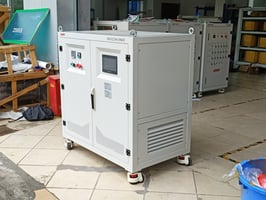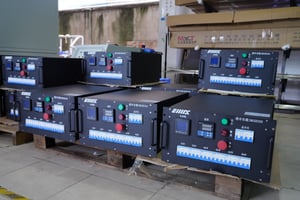A water-cooled load bank is an essential tool in industries where power systems need to be tested...
What is a UPS Load Bank? | EMAX Load Bank
In today's world, Uninterruptible Power Supplies (UPS) play a critical role in ensuring the continuity and reliability of power to essential systems. From data centers to hospitals, and industrial operations to office environments, UPS systems safeguard against power interruptions that could otherwise result in data loss, equipment damage, and significant financial implications. However, to ensure these UPS systems operate optimally and provide the necessary backup power when needed, regular testing is essential. This is where UPS load banks come into play.
Understanding UPS Load Banks
A UPS load bank is a device used to simulate electrical loads to test the performance and reliability of a UPS system. Essentially, it mimics the actual electrical load that the UPS would encounter during a power failure, allowing for comprehensive testing without risking the connected equipment.
Components of a UPS Load Bank
- Load Elements: These are resistive, inductive, or capacitive elements that simulate the load on the UPS. Resistive elements convert electrical energy into heat, inductive elements simulate motors and transformers, and capacitive elements mimic electronic devices.
- Control System: This allows for the adjustment and monitoring of the load applied to the UPS. Advanced control systems enable precise load steps and detailed data logging.
- Cooling System: Load banks generate significant heat during operation. A cooling system, often involving fans or liquid cooling, dissipates this heat to maintain safe operating temperatures.
- Safety Features: These include overload protection, emergency stop mechanisms, and thermal cutoffs to ensure safe operation during testing.
Why Use a UPS Load Bank?
Ensuring Reliability
One of the primary reasons for using a UPS load bank is to ensure the reliability of the UPS system. By regularly testing the UPS under simulated load conditions, potential issues can be identified and addressed before they result in a failure during an actual power outage.
Verifying Capacity
UPS systems are rated for specific capacities. Load banks help verify that the UPS can handle its rated capacity and deliver the required power during an outage. This is particularly important for new installations or after upgrades to existing systems.
Battery Testing
The batteries in a UPS system degrade over time. Load banks can simulate the load to test the battery's capacity and performance, ensuring they provide adequate runtime during a power failure.
Preventive Maintenance
Regular load bank testing is a key component of preventive maintenance for UPS systems. It helps identify potential problems, such as battery degradation or component failures, before they cause unplanned downtime.
Compliance and Certification
In many industries, regular UPS testing is required to comply with regulations and standards. Load banks provide a controlled and safe method to conduct these tests, ensuring compliance and certification.
Types of UPS Load Banks
Resistive Load Banks
Resistive load banks simulate a purely resistive load, converting electrical energy into heat. They are straightforward and commonly used for testing the full capacity of a UPS system.
Inductive Load Banks
Inductive load banks simulate inductive loads, such as motors and transformers. They are used to test the UPS's ability to handle reactive power and to ensure it can support inductive loads in real-world applications.
Capacitive Load Banks
Capacitive load banks simulate capacitive loads, such as those found in electronic devices. They are less common but essential for specific applications where the UPS must support significant capacitive loads.
Combined Load Banks
Combined load banks incorporate resistive, inductive, and capacitive elements to provide a comprehensive testing solution. They can simulate complex real-world loads and provide a more accurate assessment of the UPS's performance.
How to Use a UPS Load Bank
Planning the Test
Before conducting a load bank test, it is essential to plan the test thoroughly. This includes determining the load profile, test duration, and any specific requirements for the UPS system being tested.
Setting Up the Load Bank
The load bank should be connected to the UPS system according to the manufacturer's instructions. This typically involves connecting the load bank to the output terminals of the UPS and ensuring all safety precautions are in place.
Conducting the Test
During the test, the load bank applies a controlled load to the UPS system. The load can be adjusted in steps to simulate different load conditions. Key parameters such as voltage, current, and battery performance should be monitored and recorded throughout the test.
Analyzing the Results
After the test, the data collected should be analyzed to identify any issues or areas for improvement. This includes checking for voltage drops, battery performance, and overall UPS capacity.
Reporting and Maintenance
The results of the load bank test should be documented and used to inform maintenance and any necessary repairs or upgrades to the UPS system. Regular load bank testing should be scheduled as part of a comprehensive preventive maintenance program.
Benefits of Using UPS Load Banks
Improved Reliability
Regular load bank testing improves the reliability of the UPS system by identifying potential issues before they cause a failure. This ensures that the UPS is ready to provide backup power when needed.
Extended Equipment Life
By identifying and addressing issues early, load bank testing helps extend the life of the UPS system and its components. This includes batteries, which can be replaced before they fail completely.
Cost Savings
Preventive maintenance, including load bank testing, helps avoid costly downtime and repairs. It also ensures that the UPS operates efficiently, reducing energy costs.
Compliance and Certification
For industries where compliance with regulations and standards is essential, load bank testing provides a controlled and documented method to ensure the UPS system meets all requirements.
Peace of Mind
Knowing that the UPS system has been thoroughly tested and is operating reliably provides peace of mind for facility managers, IT professionals, and business owners.
Real-World Applications of UPS Load Banks
Data Centers
Data centers rely heavily on UPS systems to ensure continuous operation. Load bank testing is a critical component of data center maintenance, ensuring that backup power is available to protect sensitive data and equipment.
Hospitals
In healthcare, reliable power is essential for patient safety and the operation of critical medical equipment. Load bank testing ensures that hospital UPS systems are ready to provide backup power during an outage.
Industrial Facilities
Industrial operations often involve complex and sensitive equipment that requires continuous power. Load bank testing helps ensure that UPS systems in industrial facilities are capable of providing the necessary backup power.
Commercial Buildings
Commercial buildings, such as offices and retail spaces, use UPS systems to protect against power interruptions. Regular load bank testing ensures these systems are reliable and ready to support business operations during an outage.
Telecommunications
Telecommunications infrastructure relies on UPS systems to ensure continuous communication services. Load bank testing helps verify that these systems are capable of providing backup power when needed.
Choosing the Right UPS Load Bank
Load Capacity
When selecting a UPS load bank, it is essential to choose one with the appropriate load capacity for the UPS system being tested. This ensures accurate testing and avoids overloading the load bank.
Load Type
The type of load bank needed depends on the specific requirements of the UPS system. Resistive, inductive, capacitive, and combined load banks are available to simulate different load conditions.
Control Features
Advanced control features, such as programmable load steps and data logging, provide more precise testing and detailed analysis. These features are essential for comprehensive testing and reporting.
Safety Features
Safety features, such as overload protection and emergency stop mechanisms, are crucial for safe operation during testing. Ensure that the load bank has adequate safety features to protect both the equipment and personnel.
Portability
For facilities with multiple UPS systems or those that require testing in different locations, a portable load bank may be the best choice. Portable load banks are easy to transport and set up, providing flexibility for testing.
Manufacturer Reputation
Choose a load bank from a reputable manufacturer with a proven track record of quality and reliability. This ensures that the load bank will perform as expected and provide accurate results.
Conclusion
A UPS load bank is an essential tool for ensuring the reliability and performance of UPS systems. By simulating electrical loads, load banks provide a safe and controlled method to test UPS systems, verify their capacity, and identify potential issues before they result in a failure. Regular load bank testing is a key component of preventive maintenance, helping to extend the life of UPS systems, avoid costly downtime, and ensure compliance with regulations and standards.
Whether in data centers, hospitals, industrial facilities, or commercial buildings, the use of UPS load banks provides peace of mind, knowing that the UPS system is ready to provide backup power when needed. By choosing the right load bank and conducting regular testing, organizations can ensure their critical systems remain operational during power interruptions, protecting both equipment and operations
EMAX Load Bank is an equipment company that provides test systems for the generation, transmission, conversion, control and use of electrical energy based on load banks.






